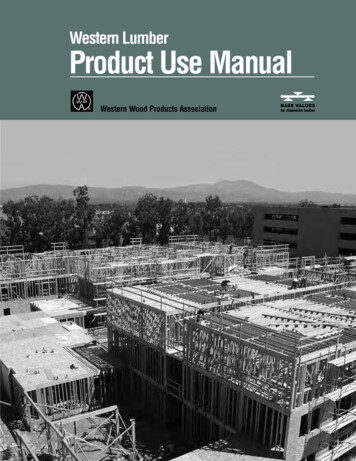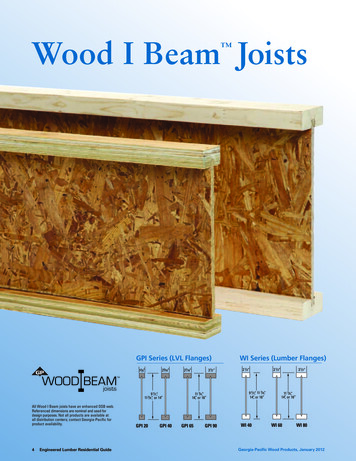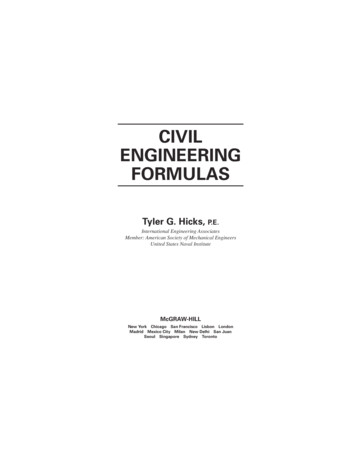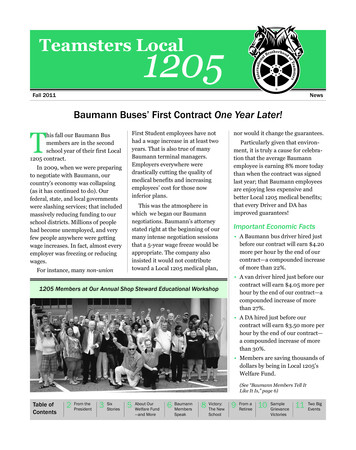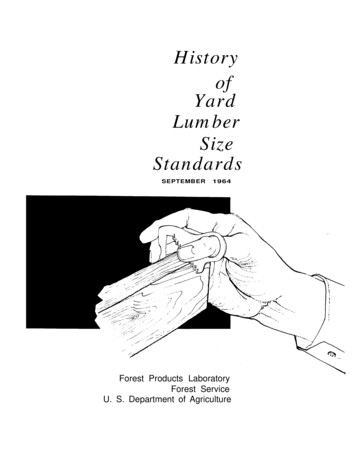
Transcription
t Products LaboratoryForest ServiceU. S. Department of Agriculture
The Forest Products Laboratoryis maintained at Madison, Wis.,in cooperation with the University of Wisconsin.
HISTORY OF YARD LUMBER SIZE STANDARDSByL. W.SMITH, Wood Technologist1and2L. W. WOOD, E n g i n e e rForest Service, U.S. Department of Agriculture---SummaryLumber size standards came into being almost a century ago to meet the need for a commonunderstanding between the mill and markets that were separated by increasing distances ofrail or water transportation. Early concepts called for rough lumber to be of full nominalsize, often in the dry condition. After World War I, the increasing demand for constructionlumber led to the first national size standard in 1924. This was revised in 1926, 1928, 1939,and 1953, while still another revision is proposed for adoption in 1964.Demand for lumber in World War II led to the shipment and use of large quantities of lumberdressed green to standard sizes. That use has continued to the present time, while experiencehas accumulated on how to deal with the seasoning and shrinkage of lumber in place in astructure. The proposed new lumber standard recognizes both green and dry lumber, requiringthe former to be of larger size so that both will be of the same size when they reach the samemoisture content in use.Economic pressures among the regional areas of lumber production have resulted in adecrease of standard lumber sizes over the period covered by this history.IntroductionDeclining markets for lumber have been a source of grave concern for the lumber industryand the Forest Service. The industry has studied its marketing problems and concluded thatthinner sizes of boards and dimension are desirable. These proposals have far-reaching effectsand have provoked widespread discussion. The purpose of this report is to summarize the background of yard lumber size standards and thus to add depth and meaning to the discussions.Standards of size, weight, and quantity have been with us for a long time. Such standards a r enecessary to a common understanding of value. Standards can be amended or changed. Forexample, the inch of today is much different from the “three barleycorns” of ancient England.Changes of standards may result from changing economic conditions, but important technicalconsiderations may also be involved.12Formerly of Division of Forest Products and Engineering Research, Washington Office.ForestProductsLaboratory,Madison,Wisconsin.
Today’s close competition within the lumber industry and between lumber and other buildingmaterials has tended to emphasize price over quality. A smaller size means a lower price fora piece of lumber to do a specific job. It has always been recognized, however, that lumbermust give satisfaction if it is to hold its markets. Technical questions of the lumber sizenecessary to do a particular job satisfactorily have therefore been a continuing part of thediscussion of lumber size standards. An analogy might be that a man who has eggs to sell in adistant market can offset transportation costs by furnishing smaller and therefore cheapereggs--provided the customer will accept and be satisfied with the smaller eggs.In any consideration of lumber standards, the basic rough green thickness of common boardsand dimension lumber is often the focalpoint of discussion. Sometimes the rough green size isconfused with the “set-out” (amounts by which the log is advanced between cuts of the saw).The set-out includes the saw kerf, which is a variable. As a result, one producer might set1-1/8 inches to saw 1-inch rough green lumber from which to make 13/16-inch dry surfacedlumber. Another producer with different equipment might have to set much thicker to arrive ata comparable end product.Thickness standards of boards and dimension are discussed because these are basic to thecost and the uses of most construction lumber.Early StandardsUntil the middle of the 19th Century, building lumber was usually produced in a locality closeto the place where it was to be used. Sizes were not a problem. The needs of builders in thelocality were well understood and carpenters were accustomed to much more hand fitting on thejob than they a r e today. As the forests were cut back from the centers of population, lumberhad to be shipped greater distances. By the last few decades before 1900, lumber was no longera locally made commodity. It then became apparent that the sizes used in different tradingareas were not uniform and as a result sawmills had to cut lumber for the markets they wishedto serve.The lumber taken fromoldhouses is revealing in its variety. By 1900, 2 inches was the mostcommon thickness for joists, rafters, studs, andthelike, and 1 inch for boards. At first, littledifficulty was experienced with the varying size standards because the sawmills of a regionsold their lumber, for the most part, in certain trade areas. However, as rail shipment oflumber increased during the last half of the 19th Century, lumber from distant regions beganto move into trade areas that had been served previously by the local region. Differingmanufacturing standards then became important, For rough lumber, the size variations werenot great, but for surfaced lumber it was a different story.Rough lumber has the disadvantage of varying in thickness and width. Therefore, before theadvent of mill surfacing, boards were planed by hand or in local planing mills when a uniformthickness or a finished surface was needed. Dimension was fitted into place by the carpenter,more often than not with his hatchet. Some enterprising sawmills started the practice ofbringing dimension lumber to a uniform width by passing each piece through a small edger o rrip saw before shipping. This was known as saw sizing and the width was usually 1/4-inchscant of the nominal width. Sawmills began to use planers sometime after 1870 and these-2-
machines provided an additional means of making rough lumber more uniform. This was reallynot a finishing operation. It was a sizingprocedure. Boards were commonly surfaced one side(S1S), sometimes S2S. Dimensionwas worked S1S1E. Lumber surfaced on four sides (S4S) couldbe had at additional charge. This custom of preparing lumber for sale persisted in someregions for many years. Even as late as the 1920’s some big mills based their prices on roughor saw-sized dimension, boards S1S, and made an additional charge of 1 per thousand forlumber S2S, S1S1E, or S4S.When surfacing at the mill became common practice, it was readily apparent that thereduction in weight meant a saving in freight charges. Therefore it was possible to get intohighly competitive markets that could not be attained with rough lumber because of its greaterweight. Writing on the subject in August 9, 1919, issue of the American Lumberman, the editorsaid:Scant allowance was originally to allow for seasoning and came about graduallyas the rail movement of lumber increased. Here very material freight savingscame into the picture. Most of the evolution toward nominal sizes seems to haveoccurred during the period of introduction of southern yellow pine into the Northand was defended on the basis that southern yellow pine was stronger thannorthern white pine scantling.Persons who think in terms of present prices and motor truck transportation may wonder atthe effect of rail freight on competitive selling prices. To bring the matter into the properperspective we should recall that costs, prices, salaries, and the like, were far different in1900 than they are now. Although there were great fluctuations in demand and prices between1880 and 1920, during this period a great deal of lumber was sold f.o.b. mill at a price considerably lower than the freight cost to deliver it. Some f.o.b. mill prices fell below 10 perthousand board feet, and freight was often more than 20 per thousand. Sales costs were lower,too. Under the circumstances, the stage was all set for sizes to be reduced as much as marketconditions would permit.The lumber manufacturers associations generally adopted size standards for the lumbermanufactured by their members. Some of these early size standards follow:(1) North Carolina Pine Association Grading Rules revised to April 1, 1906:All lumber shall be well manufactured and well dried. One-eighth inch shall beallowed to dress 4-4, 5-4, 6-4, and 8-4 lumber one side. Three-sixteenth inchshall be allowed to dress 4-4 and 5-4 lumber two sides. One-fourth inch shall beallowed to dress 6-4 and thicker lumber two sides.The rules include nothing about edge dressing except for matched lumber which was specifiedto 1/2 inch scant of nominal.(2) Pacific Coast Lumber Manufacturers Association Standard Dimensions and GradingRules for Export Trade, copyright 1902:Sizes 4 inches and under in thickness or 6 inches and under in width will beworked 1/8 inch less for each side or edge surfaced.Sizes over 4 inches in thickness or over 6 inches in width will be worked 1/4inch less for each side surfaced.Tongued and grooved, surfaced one side, will be worked 1/8 inch less in thickness; 5/8 inch narrower on face.-3-
Above references being to “Green” lumber, the worked sizes if of partially orwholly seasoned lumber, will be proportionately less, as determined by theshrinkage.The grading rules of PCLMA covering rail shipments, adopted March 30, 1906, do not includedefinitions of standard sizes.(3) Southern Cypress Manufacturers Association Grading Rules adopted July 18, 1906:4/4 lumber S1S or S2S shall be 13/16 inch thick.8/4 lumber S1S or S2S shall be 1-3/4 inches thickAll lumber S1E takes off 3/8 inch, S2E 1/2 inch.(4) Yellow Pine Manufacturers Association Grading Rules adopted January 24, 1906:Sizes of Boards 1 inch S1S or S2S to 13/16 inch. Sizes. Dimension shall be workedto the following: 2 x 4 S1S1E to 1-5/8 x 3-5/8 inches; 2 x 6 S1S1E to 1-5/8 x5-5/8 inches; 2 x 8 S1S1E to 1-5/8 x 7-1/2 inches; 2 x 10 S1S1E to 1-5/8 x 9-1/2;2 x 12 S1S1E to 1-5/8 x 11-1/2 inches. Dimension S4S 1/8 inch less than standardsize S1S1E.Rough-Common Boards and Fencing must be well manufactured, and should not beless than 7/8 inch when dry.Rough 2-inch Common shall be well manufactured and not less than 1-7/8 inchesthick when green, or 1-3/4 inches thickwhen dry. The several widths must not beless than 1/8 inch over the standard dressing width for such stock.A later listing of standard sizes was included in Kellogg’s “Lumber and Its Uses,” dated 19143(3) (see Appendix A).These early efforts by the associations to standardize lumber sizes, while generally helpful,emphasized the differences in manufacturing practice between regions. Then too, much lumberwas sold without reference to association rules o r standards. Consequently, so far as the retailpurchaser was concerned, lumber sizes were mostly an unknown quantity. The situation, if anything, became more confused as a result of the shortages and controls brought on by the FirstWorld War and the subsequent seller's market that ran on through 1919. In connection with anarticle on sawmill operation, a contributor to the American Lumberman of July 6, 1918, had thefollowing to say about sizes:There are several standards of thickness in different parts of the country butmost mills cut the great bulk of their lumber for some certain market where thestandard for dressed lumber is well established and where anything thinner willnot be accepted except at a lower price, and in some cases will not be acceptedat any price. One would naturally expect to find the thickness of all lumberintended for the same market practically the same, but as a matter of fact thereverse is true and there is considerable variation in the thickness of lumber atdifferent mills that sell in the same market.The author went on tomeasuring 32/32 inch.3recommenda standard product based on a rough green boardU n d e r l i n e d numbers in parentheses refer to Literature Cited at end of report.-4-
NationalStandardizationAfter World War I stopped in the fall of 1918, the pent-up demand for construction resulted inan ever-increasing demand for lumber continuing all through 1919. When placing orders, theemphasis was on shipments and not on details of specifications and price. Retail dealers werenot entirely happy with conditions, and demands for better standardization among associationswere heard. At a manufacturers meeting in March 1919, JohnLloyd a Philadelphia retailer,pointed to a need for standardization; in July 1919, H. J. Meyers, President of the PennsylvaniaLumbermen’s Association, spoke of standard sizes at an Association meeting and got supportfor fixed standards like weights and measures. At this meeting the recommendations were for13/16-inch S2S boards with edges not more than 1/4 inch scant of the nominal width.Probably because of the apparent growing need for more uniform lumber, this subject wasincluded in the agenda of the American Lumber Congress, which met in April 1919. Among theresolutions adopted at the Congress was one dealing with uniformity of lumber and moldings,and a committee was formed to consider the entire field of lumber standardization. This committee met on June 30 and came to the conclusion that standardization was needed in sizes,grades, nomenclature, forms, and moldings. A resolution was adopted asking the NationalLumberManufacturers Association to investigate and submit its findings to retailers andmanufacturers.For some years the U. S. Forest Products Laboratory had studied comparative grades andmanufacturing practice in the. several lumber-producing regions of the United States. Consequently, the advice of the Laboratory was sought by the NLMA and recommendations weremade. Briefly, the Laboratory found that more than 60 percent of the surfaced boards producedin the United States were 13/16 inch thick air dry and that more than 60 percent of the dimension was surfaced to an air-dry thickness of 1-5/8 inches. These basic sizes were recommended and on March 18,1920, were adopted by the Southern Pine Association and on March 31by the North Carolina Pine Association.The Forest Products Laboratory studies resulted in the publication of “Standard GradingSpecifications for Yard Lumber,” in 1923 as Circular 296 of the Department of Agriculture (2).The foreword to that publication indicated the four main divisions of the field of lumber standardization as (1) hardwood lumber, (2) softwood factory lumber, (3) structural timbers, and(4) yard lumber. Circular 296 dealt with yard lumber and a companion, Circular 295, “BasicGrading Rules and Working Stresses for Structural Timbers,” dealt with structural lumber (4).In preparing Circular 296, the Laboratory made field studies at 75 sawmills and gaveextended consideration to the most economical thickness of lumber for both producers andconsumers. They concluded that 13/16 inch was the most suitable thickness for 1-inch boardssurfaced on two sides when seasoned to the proper moisture content for the use intended. Theysimilarly recommended 1-5/8 inches for the thickness of dressed 2-inch dimension. Theyreported that the following allowances for drying and surfacing a 1-inch board are reasonable:variation in sawing 1/16 inch; seasoning (air-dry, 15 percent range), 1/32 inch; surfacing,3/32 inch. Circular 295 did not discuss standard sizes.-5-
It is worth noting that so far standard sizes had been premised on dry lumber. The term“shipping dry” was often used in connection with shipping weights. This term, while notprecisely defined at the time, since there were no moisture meters then, was generally understood to mean air-dry intherange of what is now defined as 15 to 20 percent moisture content.The beginning of national standardization of lumber size and grading dates from 1921. Earlyin that year a group of leading lumber manufacturers paid a visit to the Secretary of Commerce, Herbert Hoover, a noted engineer. Mr. Hoover was actively interested in productsstandardization and the simplification of standards in many fields through the work of theBureau of Standards. Included in the group meeting with Mr. Hoover were John H. Kirby ofHouston, John W. Blodgett of Grand Rapids, and Edward Hines of Chicago, all prominent in theNational Lumber Manufacturers Association. This group of lumbermen proposed a simplification of both lumber size and grading standards and publication by the Bureau of Standards,supplemented by grade marking under the auspices of the various lumber manufacturers’associations. The original proposals included softwoods only and yard grades only. Consideration of hardwood standards was not involved except to the extent of hardwood interest inso-called yard lumber. The initial approach to Mr. Hoover had an interested and enthusiasticresponse.All through 1921 various groups of lumber manufacturers, wholesalers, and retail dealersconsidered size standards for lumber. Numerous meetings were held. Appendix B givesrecommendations from one such meeting in October 1921.Meanwhile, the opening of the Panama Canal in 1914 had provided a means for the intercoastal shipment of heavy, bulky goods such as lumber at a considerable freight saving. Thisis important to a discussion of lumber standardization because ocean rates are based on volumerather than weight. Consequently, the moisture content of lumber had no bearing on freightcharges but size did. The shipment ofgreenlumber from the West Coast to Eastern ports wasfacilitated. At first only a few cargoes of lumber went through the Canal but after the war,beginning about 1920, the traffic began in earnest. The Weyerhaeuser Company, A. C. Dutton,and others handling western lumber built large terminals on the East Coast. Weyerhaeuser’sbig Baltimore terminal received its first multimillion foot shipment about the end of 1921 orearly in January 1922. Very few boards were shipped. Quite a bit of the 2-inch green dimensionwas S4S, 1/4 inch scant to allow for subsequent shrinkage.Standardization continued to be a live topic of discussion among lumbermen. The AmericanLumberman for January 29, 1922, reported an address by Samuel Roberts of Norristown, Pa.,at a meeting of the Pennsylvania Lumbermen’s Association in part as follows:During the last 4 or 5 years the irregularity in the sizes of rough and dressedlumber has become very pronounced, and if there is not a very definite andpositive stand taken by the retailers, there is no telling where it will extend. Oneof the many reasons that has produced this thin and narrow lumber that we areafflicted with today is the keen competition between the manfacturers having thelong haul and the short haul on the railroads. This has caused the manufacturerwith the long haul to try to meet his competititor’s price by putting on the marketthinner lumber, thereby equalizing the difference in the freight rates.-6-
Roberts observed that retailers share the blame and to illustrate his points showed how thePhiladelphia Building Code had been changed over the years from 3 by 9 rough for ordinaryjoists to 2 by 10 and 1-3/4 by 10 rough and then to 1-5/8 by 9-1/2. The change was brought onby the retailers. The meeting then recommended some standard sizes as:Rough, not more than 1/8 inch scant of nominal dimension; surfaced boards,13/16 inch thick and 3/8 inch scant in width; surfaced dimension, 1/4 inch scantin thickness and 3/8 inch scant in widthFor some time the western shippers had field men traveling in the eastern marketspromoting western lumber. At a West Coast Lumbermen’s Association meeting in February1922, reported in the American Lumberman for February 25, 1922, one of the field men,C. J. Hogue, reported as follows, “The West Coast standard of size and practice of dressinggreen from the saw is beginning to take.” However, he reported an insistent demand for fullsize stock seasoned before dressing. He said further that the eastern retailer handling WestCoast standard lumber had the practice and prejudice of years to overcome.Apparently there had been talk of the Federal Government entering the field of lumberstandards because Mr. Hogue continued, “Government regulation cannot say what size a manwill cut his lumber but it can say how much of a spread there shall be between the actual sizeand the nominal size and this is inevitably what will happen unless lumbermen can agree onsatisfactory standards among themselves to satisfy the ultimate customer that he is gettingwhat he pays for.”Another field man, C. G. Garner, recommended the abolishment of dressing green, thestandardization of sizes, and said that the manufacturers should stand the shrinkage.This meeting was attended by a group of retailers from the Northeastern Retail LumberDealer’s Association who were traveling in the West. One of these dealers, Mr. K. B. Schotteof Amsterdam, N.Y., criticized green dressing and scant sizes and replying to him Mr. W. M.Boner of the Weyerhaeuser Co. said, “The trade wants this change (dry size standard) but theywon’t pay for it. We have never been encouraged to get away from scant sizes. I’ll say this:This thing of surfacing green is wrong. But there is a question in my mind whether you wouldbuy it (dry). I’m willing to reform if we’ve got a market for it.”The American Lumber Congress met early in April 1922. Among the actions of the Congresswas a recommendation that the West Coast Lumber Manufacturers Association and the SouthernPine Association agree on standardization so that national standards could be established. OnApril 4, Secretary of Commerce Hoover spoke of the activities of his department in the field ofstandardization and strongly encouraged continuing interest and activity on the part of thelumber industry.The next day the meeting passed a resolution to the effect that a committee appointed by theNational Lumber Manufacturers Association confer with Mr. Hoover about standards andrelated matters. Later the meeting was set for 4 days beginning on May 22.-7-
Most of the various lumber groups, manufacturers, wholesalers, and retailers preparedstatements of their view in preparation for the May meetings. For example, the wholesalersformulated a recommendation which may be summarized as follows:A. Standard grading rules.B. Uniform grade branding.C. Car cards.D. National inspection bureau to be created by Congress to function under the Department of Commerce or the Forest Service.E. Control of standards under the Federal Trade Commission to prevent misbranding.F. Compulsory arbitration of disputes.A delegation of wholesalers presented these recommendations to Mr. Hoover and reportedthat he was kindly disposed to the suggestion that a national inspection bureau be created butthat he was inclined to believe that inspection could be taken care of within the industry.Just a few days before the standardization meeting, the West Coast Lumbermen approved aprogram of size standardization and tally cards. The details are not available.The American Lumberman for May 27, 1922, reported on the conference with Mr. Hooverduring which he had urged the formation of a national inspection bureau within the industry.The next week a good start toward standardization was reported. Specifically mentioned wasagreement between manufacturers and retailers on patterns and sizes of flooring, ceilings,partition, and drop siding. Arrangements were made for further regional conferences.So far the details of only softwoodlumber standards had been considered. Now some thoughtwas given to hardwood standards. These were uniform throughout the country and were administered by one agency so there was no apparent need for consideration of hardwood grades andmanufacturing standards. However, it was reported on June 24 that the Hardwood Manufacturers Institute endorsed the standardization program.One can infer from reading the trade journals, like the American Lumberman, of mid-1922that a demand for some sort of government supervision of lumber grades and standards continued and that among lumbermen opposition to government standardization had developed.Perhaps for this reason editorials in the July 15 and July 29 American Lumberman asked forthe hearty support of and cooperation of the lumber industry with the program of the Department of Commerce. Dr. Wilson Compton of the National Lumber Manufacturers Associationissued a statement to the effect that a constructive program of standardization of industrywould bury public agitation for government regulation.About this time lumber representatives met in what were called standardization meetingsin Madison, Wis.; Chicago, Ill.; and Portland, Oreg. The meeting in Madison centered aroundthe basic grades proposed by the Forest Products Laboratory. The meeting in Chicago had todo with sizes as well as grades. The retailers continued to favor a 13/16-inch board. Therewas some discussion about 13/16 inchwithaplus or minus tolerance of 1/16 inch based on thebelief of some that lumber could not be made closer than 1/16 inch to a stipulated size. Thisidea never got very far. However, the meeting did result in a table of recommended sizestandards, in part as follows:-8-
ManufacturersRetailersBoards*13/16-inch thickness by 3/8inch off in widths to 7inches; 1/2 inch off inwidths of 8 inches andwider.13/16-inch thickness by3/8 inch off in widthsto 8 inches; widths of10 and 12 inches, 1/2inch off.Dimension1-5/8-inch thickness by3/8 inch off in widthsto 6 inches; widths of8, 10, and 12 inches, 1/2inch off.No recommendation*The American Lumberman for July 29 reported that the following associationsvoted No.: Northern Pine Association, West Coast Lumber Manufacturers Association, and Western Pine Association.So far as can be ascertained, the Portland meeting was inconclusive.During the rest of the summer discussions and trade journal editorials on standardizationcontinued. The August 12 American Lumberman contained an article by Mr. William A. Babbitt,at that time manager of the National Association of Wood Turners, which took issue with theuniversally held view that standard sizes for lumber should be related to an inch. Mr. Babbittcompared the discussion of board thickness to the Schoolmen’s discussions of the Middle Agesabout the number of angels that could dance on the head of a pin. His contention was that thethickness of a board is related to conservation and the heart of the matter was utility.The simple fact is that the customs andprecedents of the lumber industry were so wedded to“measurement” rather than ‘utility” that Mr. Babbitt’s ideas did not make much headway. Thismatter will be discussed in greater detail later.Late in September 1922 a group of 35 delegates representing 12 eastern lumber associationsmet in New York City to discuss lumber sizes. At this meeting the group favored “giving thecustomer 16 ounces per pound,” and passed a resolution regarding lumber sizes in part asfollows :Rough 2-inch dimension shall be full width and thickness allowing 1/8 inch in10 percent of the shipment for imperfect manufacture or uneven drying. Roughboards shall be full except for 1/16 inch scant in 10 percent as above. Dresseddimension shall be not less than 1/4 inchscant when dry. Dressed boards, 13/16inch by 1/4 inch scant in width when dry. Recommendations were also made onflooring and timbers.It may be noted that all eastern recommendations were based on dry lumber. Now questionswere asked about the meaning of “dry,” “shipping dry,” and like terms. In its studies ofshrinkage, the Forest Products Laboratory had used 15 percent as a moisture content to whichto relate the dry size of lumber. The term “shipping dry” was often used. This was defined inthe October 7 American Lumberman as “ready to use, will not deteriorate in storage.”Actually there was not much argument about the term “dry.” At that time the lumber industryas well as the construction industry all the way down to the carpenter (and despite the greenlumber of wartime years) were accustomed to thinking of dry lumber. The definition quotedabove had a real meaning.-9-
Development of 1924 American Lumber StandardsThe foregoing discussions and conferences led to the formation of a central committeethereafter known as the Central Committee on Lumber Standards. Its chairman was John W.Blodgett, President of the National Lumber Manufacturers Association. Its membershipincluded producers, wholesale and retail distributors of lumber, and consumers of lumber.The first formal meeting of the Central Committee was held on October 3, 1922, and therespective representatives of the manufacturers, wholesalers, and retailers had an opportunityto meet and get acquainted with their opposite numbers representing the wood-using industries,the architects, engineers, railroads, and general contractors.The Central Committee established early in December what was subsequently known as theConsulting Committee on Lumber Standards. It was composed largely of technical men representing the same interests of production, distribution, and use of lumber and timber. Thechairman of the consulting committee was Dr. Wilson Compton, then General Manager of theNLMA. It held a number of meetings whichwere well attended. Great interest was shown by allparties concerned, largely prompted by the interest manifested by the Secretary of Commerceand the help of the U. S. Forest Service.Progress became more rapid. The program and plans of procedures were presented to ameeting of retailers, engineers, and architects by William A. Durgin, Chief, Division ofSimplified Practice, Department of Commerce, and on October 16, 1922, the Central Committeepublished a statement of progress. Dimensionandboards were proposed to be 1-5/8 and 25/32inches thick dry. The resolutions of May 22 to 26 conferences were reaffirmed and generaldefinitions and nomenclature were mentioned. The origin of 25/32 inch as the thickness of a1-inch board is d
After World War I, the increasing demand for construction lumber led to the first national size standard in 1924. This was revised in 1926, 1928, 1939, and 1953, while still another revision is proposed for adoption in 1964. Demand for lumber in World War II
